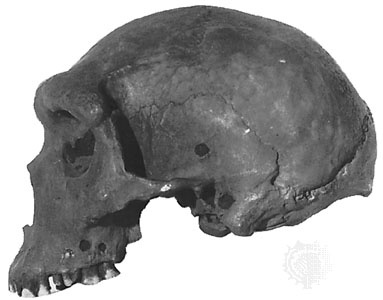Kabwe cranium
anthropology
also called Broken Hill cranium
 fossilized skull of an extinct human species (genus Homo) found near the town of Kabwe, Zambia (formerly Broken Hill, Northern Rhodesia), in 1921. It was the first discovered remains of premodern Homo in Africa and until the early 1970s was considered to be 30,000 to 40,000 years old—only one-tenth its true age. The nearly complete cranium was found in association with a jaw fragment, a sacrum, and portions of pelvis and limb bones. The fossils, popularly known as Rhodesian man and at first given the taxonomic name H. rhodesiensis, convinced some scholars that African Homo lagged behind Eurasian Homo in acquiring modern anatomy. Despite past disagreement about the classification of these specimens, they are now usually attributed to the archaic human species H. heidelbergensis (Homo heidelbergensis), along with other specimens such as those from Bodo (Ethiopia), Ndutu (Tanzania), Heidelberg (Germany), and Petralona (Petralona skull) (Greece).
fossilized skull of an extinct human species (genus Homo) found near the town of Kabwe, Zambia (formerly Broken Hill, Northern Rhodesia), in 1921. It was the first discovered remains of premodern Homo in Africa and until the early 1970s was considered to be 30,000 to 40,000 years old—only one-tenth its true age. The nearly complete cranium was found in association with a jaw fragment, a sacrum, and portions of pelvis and limb bones. The fossils, popularly known as Rhodesian man and at first given the taxonomic name H. rhodesiensis, convinced some scholars that African Homo lagged behind Eurasian Homo in acquiring modern anatomy. Despite past disagreement about the classification of these specimens, they are now usually attributed to the archaic human species H. heidelbergensis (Homo heidelbergensis), along with other specimens such as those from Bodo (Ethiopia), Ndutu (Tanzania), Heidelberg (Germany), and Petralona (Petralona skull) (Greece).The Kabwe skull has archaic features, being massive and flattened in profile with browridges that are very large and continuous across the nasal bridge. There are a large ridge across the rear of the skull and a very large palate. Even so, the cranial capacity of 1,280 cc (78 cubic inches) is nearly as large as that of modern humans. The limb bones are robust but otherwise indistinguishable from those of modern humans. The pelvis is also modern, though it has a buttress on the blade similar to those seen on H. erectus. The age of the remains is difficult to establish, but animal fossils also found at the site imply a date of 500,000 to 300,000 years ago. Unlike sites of comparable age in this region, the tool collection lacks Acheulean (Acheulean industry) hand axes, although some were found in an excavation 280 km (170 miles) away.
- Bynkershoek, Cornelis van
- Byoir, Carl
- Byrd, Richard E.
- Byrds, the
- Byrd, William
- Byrd, William, of Westover
- Byrhtferth of Ramsey
- Byrne, Barry
- Byrnes, James F.
- Byrom, John
- Byron Bay
- Byron, George Gordon Byron, 6th Baron
- Byron, John
- Byron, John Byron, 1st Baron
- Byron Nelson
- Byron R. White
- byssinosis
- byte
- Bytom
- Byzantine architecture
- Byzantine art
- Byzantine chant
- Byzantine emperors*
- Byzantine Empire
- Byzantine Greek language